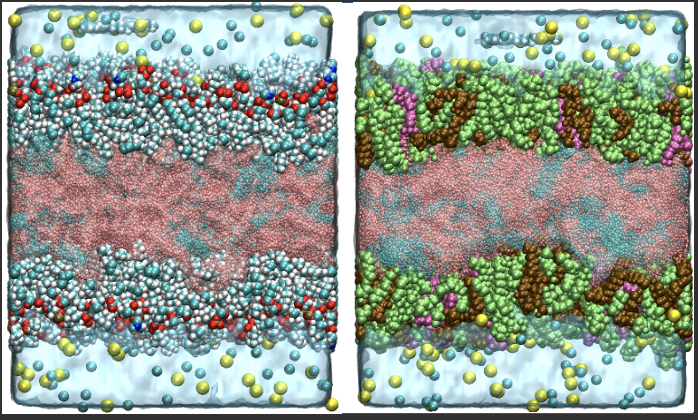Lipid droplets are cytoplasmic organelles that store neutral lipids (e.g. triacylglycerols & sterol esters) that serve as reservoirs of energy. The neutral lipid core of lipid droplets are bounded by a phospholipid monolayer, which differentiates them from most other organelles that have a bilayer membrane. There are various nano-environments of different viscosities present in these complex organelles. In collaboration with the group of Prof. Klaus Suhling (KCL, Physics), we have combined fluorescent imaging with molecular dynamics simulations to provide a detailed description of these complex fluid environments within lipid droplets.
In this manuscript, we present, for the first time, the application of time-resolved fluorescence anisotropy imaging (TR-FAIM) with fluorescent molecular rotors (FMRs) to characterise the viscosity within complex heterogeneous environments like those commonly found in biological systems. In addition to being the first time that TR-FAIM with FMRs was used to image viscosity within a complex heterogeneous environment, the importance of this work is that it:
- Provides a detailed description of the environments present within lipid droplets. We are able to measure the fluorescent lifetime and rotational correlation time simultaneously. In doing so, we break down the macroscopic concept of viscosity into distinct, measurable viscosity-related parameters. These parameters allow us to build a significantly more realistic picture of nano-environments in non-isotropic heterogeneous systems. Our results show dip-and-rise anisotropy decays due to multiple dye populations, and require special fitting to extract parameters for both populations.
- Provides an atomistic description of the different populations of the dye molecules within the two different lipid environments found in the mLDs and LDs. Using large-scale all-atom molecular dynamics simulations, we simulated the interaction of the BODIPY-C12 dye molecule with systems representative of those studied experimentally. The trajectories of these simulations were used to resolve the two populations found experimentally. As a result, we were able to assign each lifetime and rotational correlation time to an orientation of the BODIPY-C12 molecule within the two systems.

Full reference: “Time-resolved fluorescence anisotropy of a molecular rotor resolves microscopic viscosity parameters in complex environments,” I. Emilie Steinmark, Pei-Hua Chung, Robert M. Ziolek, Bethan Cornell, Paul Smith, James A. Levitt, Carolyn Tregidgo, Carla Molteni, Gokhan Yahioglu, Christian D. Lorenz & Klaus Suhling. Small (2020) 16 (22), 1907139.
